博文
R语言如何给拟合曲线添加95%置信区间?
|||
最新basicTrendline包ver2.0.3帮你解决这个问题。
安装 basicTrendline包(在R或Rstudio中运行)
从CRAN安装:
install.packages("basicTrendline")从github安装version 2.0.3版:
install.packages("devtools")
devtools::install_github("PhDMeiwp/basicTrendline@master", force = TRUE)version 2.0.3 有哪些更新?
add several arguments to
trendline()function, including show.equation, show.Rpvalue, Rname, Pname, xname, yname, yhat, CI.fill, CI.level, CI.alpha, CI.color, CI.lty, CI.lwd, ePos.x, ePos.y, las.enable to draw confidence interval for regression models (arguments CI.fill, CI.level, etc.)
add ‘show.equation’ and show.Rpvale’ arguments to enable to choose which parameter to show
add ‘Rname’ and ‘Pname’ arguments to specify the character of R-square and P-vlaue (i.e. R^2 or r^2; P or p)
add ‘xname’ and ‘ynameto’ arguments to specify the character of ‘x’ and ‘y’ in the equation
add ‘yhat’ argument to enable to add a hat symbol on the top of ‘y’ in the equation
add ‘ePos.x’ and ‘ePos.y’ arguments to specify the x and y co-ordinates of equation’s position
deleted the ‘ePos’ argument
add “Residual Sum of Squares” to the output of ‘trendline_summary()’ function
实例(8个cases)
library(basicTrendline) x <- c(1, 3, 6, 9, 13, 17) y <- c(5, 8, 11, 13, 13.2, 13.5)
[case 1] 默认case (自动添加95%置信区间lines and fill color)
trendline(x, y, model="line2P", ePos.x = "topleft", summary=TRUE, eDigit=5)
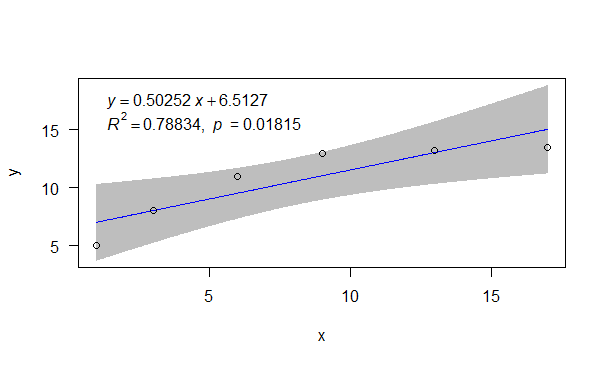
[case 2] 只添加95%置信区间的lines,不fill color (set CI.fill = FALSE)
trendline(x, y, model="line3P", CI.fill = FALSE, CI.color = "black", CI.lty = 2, linecolor = "blue")
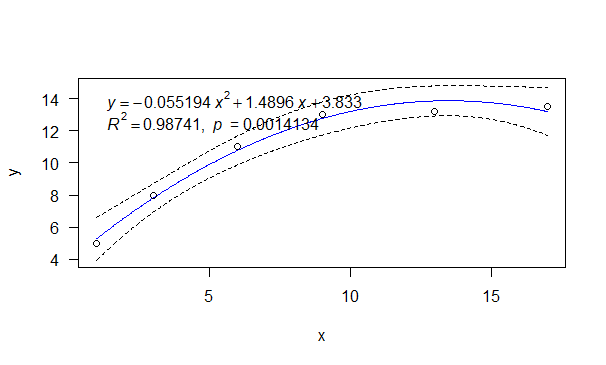
[case 3] 只绘制回归曲线,不添加95%置信区间 (set CI.color = NA)
trendline(x, y, model="log2P", ePos.x= "top", linecolor = "red", CI.color = NA)
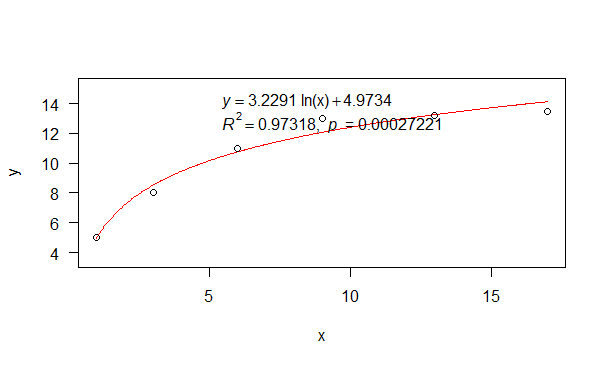
[case 4] 显示方程,不显示R值和P值 (set show.Rpvalue = FALSE)
trendline(x, y, model="exp2P", show.equation = TRUE, show.Rpvalue = FALSE)
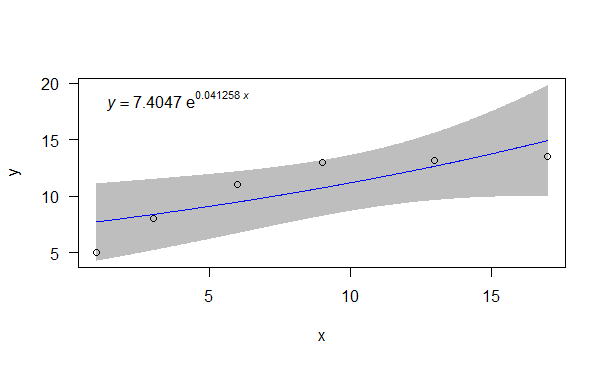
[case 5] 自定义方程中的参数的名称
see Arguments c(‘xname’, ‘yname’, ‘yhat’, ‘Rname’, ‘Pname’)
trendline(x, y, model=”exp3P”, xname=”T”, yname=paste(delta^15,”N”),
yhat=FALSE, Rname=1, Pname=0, ePos.x = “bottom”)
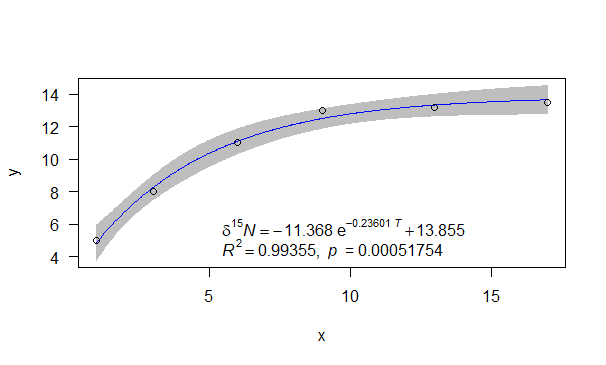
[case 6] 改变方程的 小数位,字体颜色,字号大小
trendline(x, y, model="power2P", eDigit = 3, eSize = 1.4, text.col = "blue")
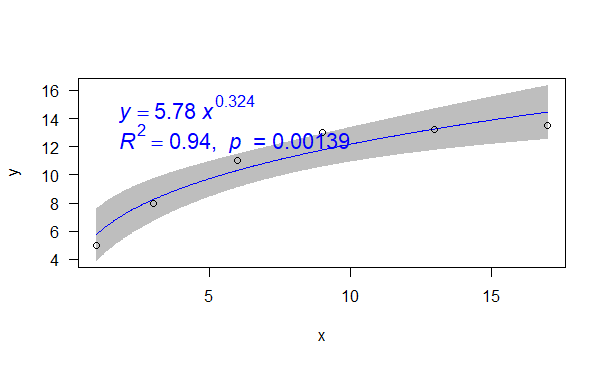
[case 7] 不显示方程,只显示回归曲线 (set ePos.x = NA)
trendline(x, y, model="power3P", ePos.x = NA)
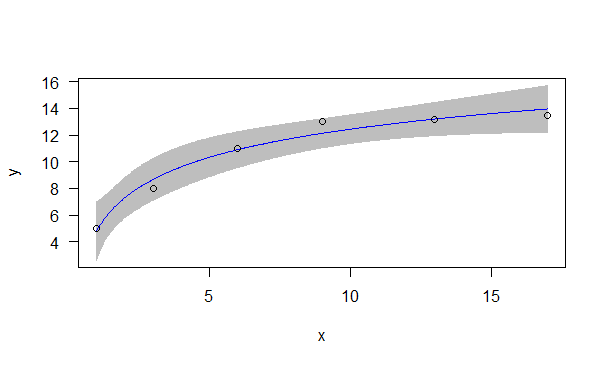
[case 8] 使用 par {graphics} 设置绘图区大小(可到ggplot2的美观效果)
缩小x轴文字的大小,x-lable和x轴之间的距离
### NOT RUN par(mgp=c(1.5,0.4,0), mar=c(3,3,1,1), tck=-0.01, cex.axis=0.9) trendline(x, y) # dev.off() ### END (NOT RUN)
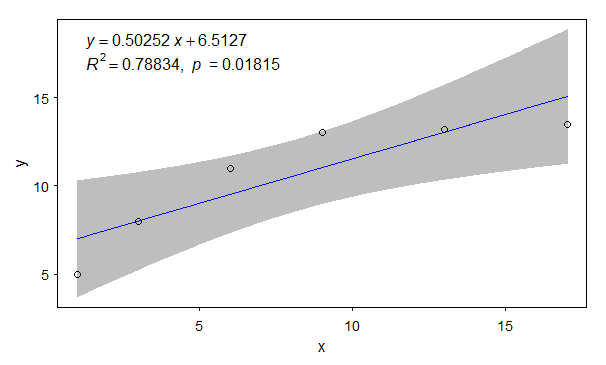
描述文件
Plot, draw regression line and confidence interval, and show regression equation, R-square and P-value, as simple as possible,
by using different models built in the ‘trendline()’ function. The function includes the following models in the latest version:
“line2P” (formula as: y=a*x+b),
“line3P” (y=a*x2+b*x+c),
“log2P” (y=a*ln(x)+b),
“exp2P” (y=a*eb*x),
“exp3P” (y=a*eb*x+c),
“power2P” (y=a*xb),
“power3P” (y=a*xb+c).
Besides, the summarized results of each fitted model are also output by default.
使用
trendline(x, y, model = "line2P", Pvalue.corrected = TRUE, linecolor = "blue", lty = 1, lwd = 1, show.equation = TRUE, show.Rpvalue = TRUE, Rname = 1, Pname = 0, xname = "x", yname = "y", yhat = FALSE, summary = TRUE, ePos.x = NULL, ePos.y = NULL, text.col = "black", eDigit = 5, eSize = 1, CI.fill = TRUE, CI.level = 0.95, CI.color = "grey", CI.alpha = 1, CI.lty = 1, CI.lwd = 1, las = 1, xlab = NULL, ylab = NULL, ...)
“参数”介绍
x, y
the x and y arguments provide the x and y coordinates for the plot. Any reasonable way of defining the coordinates is acceptable.
model
select which model to fit. Default is “line2P”. The “model” should be one of c(“line2P”, “line3P”, “log2P”, “exp3P”, “power3P”), their formulas are as follows:
“line2P”: y=a*x+b
“line3P”: y=a*x2+b*x+c
“log2P”: y=a*ln(x)+b
“exp2P”: y=a*eb*x
“exp3P”: y=a*eb*x+c
“power2P”: y=a*xb
“power3P”: y=a*xb+c
Pvalue.corrected
if P-value corrected or not, the vlaue is one of c(“TRUE”, “FALSE”).
linecolor
color of regression line.
lty
line type. lty can be specified using either text c(“blank”,”solid”,”dashed”,”dotted”,”dotdash”,”longdash”,”twodash”) or number c(0, 1, 2, 3, 4, 5, 6). Note that lty = “solid” is identical to lty=1.
lwd
line width. Default is 1.
show.equation
whether to show the regression equation, the value is one of c(“TRUE”, “FALSE”).
show.Rpvalue
whether to show the R-square and P-value, the value is one of c(“TRUE”, “FALSE”).
Rname
to specify the character of R-square, the value is one of c(0, 1), corresponding to c(r^2, R^2).
Pname
to specify the character of P-value, the value is one of c(0, 1), corresponding to c(p, P).
xname
to specify the character of “x” in equation, see Examples [case 5].
yname
to specify the character of “y” in equation, see Examples [case 5].
yhat
whether to add a hat symbol (^) on the top of “y” in equation. Default is FALSE.
summary
summarizing the model fits. Default is TRUE.
ePos.x, ePos.y
equation position. Default as ePos.x = “topleft”. If no need to show equation, set ePos.x = NA. It’s same as those in legend.
text.col
the color used for the legend text.
eDigit
the numbers of digits for equation parameters. Default is 5.
eSize
font size in percentage of equation. Default is 1.
CI.fill
fill the confidance interval? (TRUE by default, see ‘CI.level’ to control)
CI.level
level of confidence interval to use (0.95 by default)
CI.color
line or fill color of confidence interval.
CI.alpha
alpha value of fill color of confidence interval.
CI.lty
line type of confidence interval.
CI.lwd
line width of confidence interval.
las
style of axis labels. (0=parallel, 1=all horizontal, 2=all perpendicular to axis, 3=all vertical)
xlab, ylab
labels of x- and y-axis.
…
additional parameters to plot,such as type, main, sub, xlab, ylab, col.
细节描述
The linear models (line2P, line3P, log2P) in this package are estimated by lm function, while the nonlinear models (exp2P, exp3P, power2P, power3P) are estimated by nls function (i.e., least-squares method).
The argument ‘Pvalue.corrected’ is workful for non-linear regression only.
If “Pvalue.corrected = TRUE”, the P-vlaue is calculated by using “Residual Sum of Squares” and “Corrected Total Sum of Squares (i.e. sum((y-mean(y))^2))”.
If “Pvalue.corrected = TRUE”, the P-vlaue is calculated by using “Residual Sum of Squares” and “Uncorrected Total Sum of Squares (i.e. sum(y^2))”.
注意事项
Confidence intervals for nonlinear regression (i.e., objects of class nls) are based on the linear approximation described in Bates & Watts (2007).
参考文献
Bates, D. M., and Watts, D. G. (2007) Nonlinear Regression Analysis and its Applications. Wiley.
Greenwell B. M., and Schubert-Kabban, C. M. (2014) investr: An R Package for Inverse Estimation. The R Journal, 6(1), 90-100.
返回值
R2, indicates the R-Squared value of each regression model.
p, indicates the p-value of each regression model.
AIC or BIC, indicate the Akaike’s Information Criterion or Bayesian Information Criterion for fitted model. Click AIC for details. The smaller the AIC or BIC, the better the model.
RSS, indicates the “Residual Sum of Squares” of regression model.
To see examples on how to use “basicTrendline” in R software, you can run the following R code if you have the “basicTrendline” package installed:
library(basicTrendline) ?trendline()
致谢
We would like to express my special thanks to Uwe Ligges, Swetlana Herbrandt, and CRAN team for their very valuable comments to the ‘basicTrendline’ package.
Our thanks also go to those who contributed R codes by:
adding conficende interval for both lm and nls objects: https://github.com/bgreenwell/investr
adding-regression-line-equation-and-r2-on-graph-1: http://blog.sciencenet.cn/blog-267448-1021594.html
adding-regression-line-equation-and-r2-on-graph-2: https://stackoverflow.com/questions/7549694/adding-regression-line-equation-and-r2-on-graph
What is non-linear regression?: https://datascienceplus.com/first-steps-with-non-linear-regression-in-r/
adding regression line for nonlinear regression: http://blog.sciencenet.cn/blog-651374-1014133.html
R codes for ‘print.summary.nls of exp3P and power3P’ cite from https://github.com/SurajGupta/r-source/blob/master/src/library/stats/R/nls.R
Bug修复
If you have any question or comment to this package, tell me at here.
Bugs and feature requests can be filed to https://github.com/PhDMeiwp/basicTrendline/issues. BTW, Pull requests are also welcome.
PDF文件下载
The PDF file of this R package is available at https://cran.r-project.org/web/packages/basicTrendline/index.html
https://blog.sciencenet.cn/blog-651374-1126673.html
上一篇:华为麒麟芯片所需的ARM架构不是英国的,而是
下一篇:R语言可视化/作图网站推荐